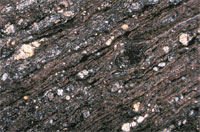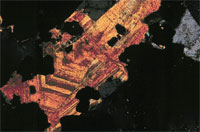



NDSU Geosciences Petrology 422/622 Spring 2010
STUDENT TERM PROJECTS


Our objective during the last section of the class is to exercise our petrology muscles, by gaining some hands-on knowledge of a specific petrologic topic, and by presenting the results of our research to an audience.
Topic Selection: Working in teams of one or two, select an igneous or metamorphic site or suite of samples that is of particular interest to you. There are a number of sample suites available in the department from previous field trips. Those of you going on a spring break trip may be able to collect samples that could be used for a project, but remember, it will take time to have thin sections made up (we send them to a commercial lab), so you'll have to work quickly upon return to get them back in time to prepare your project. You may also carry out a mathematical or geochemical modeling project based on literature data. All topics must be approved.
Titles Due: Term project titles should be turned in to me by Friday, March 12.
Research: Investigate your samples thoroughly by observing hand samples and thin sections. Chemical or SEM microchemical analysis may be possible, and XRD facilities are available in the Chemistry Dept. Carrying out relevant experiments is also a possibility. Thorough analysis of data from the literature on your sample area may be possible as a research project, but this type of project must be much more than a "book report." You are encouraged to use diverse source materials, including maps, state and federal reports, journals and books to provide background information for your project. Your project should include significant content based on your personal efforts. Be creative!
Class Presentation: For your 15 minute presentation to class, describe what motivated you to study the chosen topic, the geologic background of your samples, and a summary of the results of your research, with diagrams or pertinent data. Bring sufficient copies of a one-page double-sided summary to class. Include a "references cited" section that lists those materials that you actually used in the preparation of your report.
Presentation Dates: Presentations will be made on April 29, May 4, and May 6.
Course Points: 20% of grade
|
|
Projects: Chris BartekTitle: Sourcing Volcanic Glass Temper in Potsherds from the Va'oto Site This project examines the production techniques of ancestral Polynesian pottery excavated from the Va'oto site on Ofu Island, American Samoa. Previous ceramic analyses of the Va'oto assemblage have identified diagnostic physical attributes. Petrography will identify and source volcanic glass and this analysis will also differentiate between additional inclusions and temper. Preliminary analysis has identified volcanic glass in many of the potsherds. Volcanic glass nodules have also been recovered from the Va'oto site, and this material will be equated to parent material. Using petrographic, scanning electron microscope, and x-ray analysis, I will investigate whether volcanic glass occurred in pottery as a result of intentional tempering. This work will further our understanding of ancestral Polynesian craft specialization and resource acquisition.
Chad Crotty and Andrew Gorz
Dillon Dolezal and Lane Folkers Kelsey Forward Title: Cobbles from the Dry Valleys of Antarctica - Group 1 My project will attempt to characterize and classify a selected group of Antarctic granites using data obtained from thin sections as well as XRF. These results will then be compared to a classification scheme previously constructed to determine the most effective method of classification. The ultimate goal behind this characterization is to map and age the till in order to determine the possible source rocks, and consequently, ancient glacial drainage patterns in the Friis Hills of the Dry Valleys of East Antarctica. Steve Fried and Nick Sharp Title: Petrologic Investigation of Stone Tool Artifacts from Samoa Using both thin section and XRF analysis, we propose to determine whether our four stone tools originate from the island they were discovered on. Chemical data of the tools will be compared to the data of the island from which they were found and, if available, surrounding island data. Individual tool data will also be compared to determine if all four tools have the same origin. Michael Ginsbach Title: Geochemistry and Origins of Anorthosites from the Duluth Complex, Minnesota My project will involve using a variety of methods (XRD, SEM, Michel-Levy) to determine the composition of anorthosites from the North Shore of Lake Superior in terms of calcium and sodium levels. This chemical composition can be used to give an idea of the conditions these rocks underwent during formation. Brian Hall Title: Classification of Granite Erratics from Antarctica - Group 2 We are using granite erratics to determine ancient glacier drainage patterns in the Friis hills of Eastern Antarctica. To do this, we are going to analyze and characterize our granite samples through the use of XRD, XRF, thin section point counts, and hand sample identification. Once we have classified our samples, we will compare the data to previous studies of known granite assemblages around the Friis hills. The hope of this study is to potentially determine the origin of our granite erratics and be able to infer ancient glacier drainage patterns. Cole Neset and Tom Stewart Title: Investigation of the Flambeau Ore Deposit, Wisconsin We are using SEM - EDS analysis to investigate the mineralogy of samples from the Flambeau copper mine, Wisconsin. Spencer Salmon Title: Measurement of Water Content in Mantle Olivine I plan to use FTIR (Fourier transform infrared spectroscopy) analysis on mantle xenoliths from McMurdo Base, Antarctica. The goal is to measure the water content of the olivine xenolith. I have a sample from the McMurdo volcanic group, and also a sample from an unknown location that is not deep mantle in origin. By comparing the two spectra generated I hope to find a hydrated olivine (McMurdo) and a non-hydrated olivine (Unknown). Alex Smith Title: Cobbles from the Dry Valleys of Antarctica - Group 3 I am characterizing granite from tills which have been recently mapped in the Dry Valleys. I used point counts and XRF analysis to determine the key characteristics between the different granite. The aim of this project is to establish how many granite types there are? Determine if the granite source outcrops can be located? And if granite content in the tills can be used to identify individual till sheets. Ashley Steffen and Josh Swanson Title: Investigation of Gneiss from Nelson County, Virginia We will be investigating samples of the Lovingston Gneiss of the Blue Ridge Basement Complex from Nelson County, Virginia. This rock is associated with the Grenville Orogeny. By using X-ray diffraction and thin sections, we will describe the texture and mineralogy, and attempt to depict the history of the rock. Bailey Uran and Tanner Schmidt Title: Characterization of Volcanic Rock from the Valley of Fire, New Mexico We are researching a rock collected by Tanner while visiting the Carrizozo Malpais, also known as the Valley of Fire. This area is located in the southern part of New Mexico. Our main goal is to figure out the mineralogy and petrology of our basalt lava flow sample. We will do this by looking at a thin section of our sample and identifying the minerals and textures in the rock. We will also run XRF chemical analysis and XRD of our sample. After analyzing our sample we will then compare our results to data published regarding the area. Kevin Westland Title: Characterization of Shonkinite from the 4 Sisters Ranch, Montana I plan on determining the minerals present in the Shonkinite rock sample by making a XRD analysis and a thin section and hand sample description, and then comparing it to what literature has said. Also discuss a brief history of the origin of this rock in the Shonkin Sag area. 
NDSU Home | Geosciences Home | Petrology Home Page | B. Saini-Eidukat Petrology Geology 422/622 |